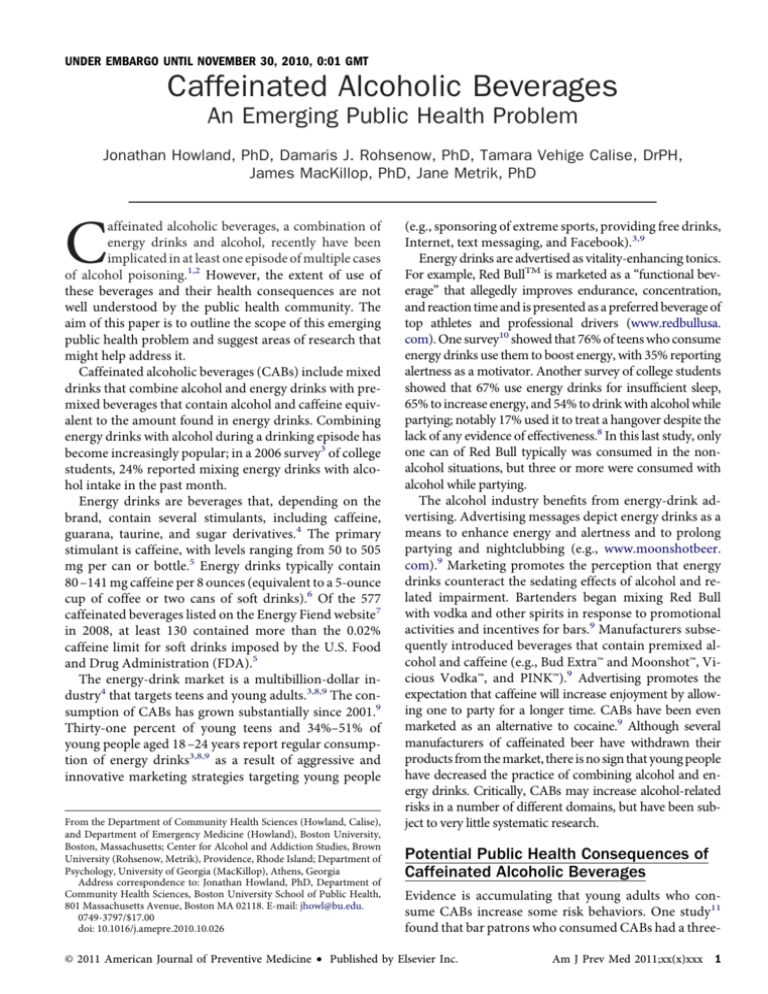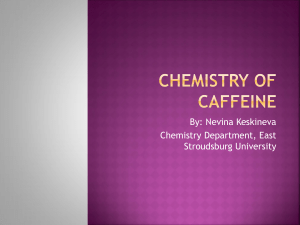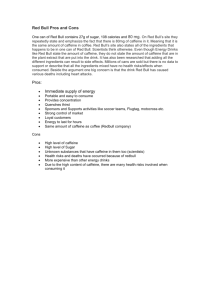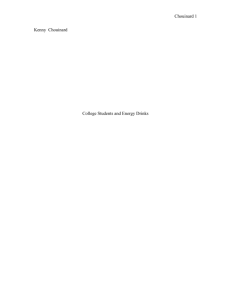Caffeinated Alcoholic Beverages
advertisement

UNDER EMBARGO UNTIL NOVEMBER 30, 2010, 0:01 GMT Caffeinated Alcoholic Beverages An Emerging Public Health Problem Jonathan Howland, PhD, Damaris J. Rohsenow, PhD, Tamara Vehige Calise, DrPH, James MacKillop, PhD, Jane Metrik, PhD C affeinated alcoholic beverages, a combination of energy drinks and alcohol, recently have been implicated in at least one episode of multiple cases of alcohol poisoning.1,2 However, the extent of use of these beverages and their health consequences are not well understood by the public health community. The aim of this paper is to outline the scope of this emerging public health problem and suggest areas of research that might help address it. Caffeinated alcoholic beverages (CABs) include mixed drinks that combine alcohol and energy drinks with premixed beverages that contain alcohol and caffeine equivalent to the amount found in energy drinks. Combining energy drinks with alcohol during a drinking episode has become increasingly popular; in a 2006 survey3 of college students, 24% reported mixing energy drinks with alcohol intake in the past month. Energy drinks are beverages that, depending on the brand, contain several stimulants, including caffeine, guarana, taurine, and sugar derivatives.4 The primary stimulant is caffeine, with levels ranging from 50 to 505 mg per can or bottle.5 Energy drinks typically contain 80 –141 mg caffeine per 8 ounces (equivalent to a 5-ounce cup of coffee or two cans of soft drinks).6 Of the 577 caffeinated beverages listed on the Energy Fiend website7 in 2008, at least 130 contained more than the 0.02% caffeine limit for soft drinks imposed by the U.S. Food and Drug Administration (FDA).5 The energy-drink market is a multibillion-dollar industry4 that targets teens and young adults.3,8,9 The consumption of CABs has grown substantially since 2001.9 Thirty-one percent of young teens and 34%–51% of young people aged 18 –24 years report regular consumption of energy drinks3,8,9 as a result of aggressive and innovative marketing strategies targeting young people From the Department of Community Health Sciences (Howland, Calise), and Department of Emergency Medicine (Howland), Boston University, Boston, Massachusetts; Center for Alcohol and Addiction Studies, Brown University (Rohsenow, Metrik), Providence, Rhode Island; Department of Psychology, University of Georgia (MacKillop), Athens, Georgia Address correspondence to: Jonathan Howland, PhD, Department of Community Health Sciences, Boston University School of Public Health, 801 Massachusetts Avenue, Boston MA 02118. E-mail: jhowl@bu.edu. 0749-3797/$17.00 doi: 10.1016/j.amepre.2010.10.026 (e.g., sponsoring of extreme sports, providing free drinks, Internet, text messaging, and Facebook).3,9 Energy drinks are advertised as vitality-enhancing tonics. For example, Red BullTM is marketed as a “functional beverage” that allegedly improves endurance, concentration, and reaction time and is presented as a preferred beverage of top athletes and professional drivers (www.redbullusa. com). One survey10 showed that 76% of teens who consume energy drinks use them to boost energy, with 35% reporting alertness as a motivator. Another survey of college students showed that 67% use energy drinks for insuffıcient sleep, 65% to increase energy, and 54% to drink with alcohol while partying; notably 17% used it to treat a hangover despite the lack of any evidence of effectiveness.8 In this last study, only one can of Red Bull typically was consumed in the nonalcohol situations, but three or more were consumed with alcohol while partying. The alcohol industry benefıts from energy-drink advertising. Advertising messages depict energy drinks as a means to enhance energy and alertness and to prolong partying and nightclubbing (e.g., www.moonshotbeer. com).9 Marketing promotes the perception that energy drinks counteract the sedating effects of alcohol and related impairment. Bartenders began mixing Red Bull with vodka and other spirits in response to promotional activities and incentives for bars.9 Manufacturers subsequently introduced beverages that contain premixed alcohol and caffeine (e.g., Bud Extra™ and Moonshot™, Vicious Vodka™, and PINK™).9 Advertising promotes the expectation that caffeine will increase enjoyment by allowing one to party for a longer time. CABs have been even marketed as an alternative to cocaine.9 Although several manufacturers of caffeinated beer have withdrawn their products from the market, there is no sign that young people have decreased the practice of combining alcohol and energy drinks. Critically, CABs may increase alcohol-related risks in a number of different domains, but have been subject to very little systematic research. Potential Public Health Consequences of Caffeinated Alcoholic Beverages Evidence is accumulating that young adults who consume CABs increase some risk behaviors. One study11 found that bar patrons who consumed CABs had a three- © 2011 American Journal of Preventive Medicine • Published by Elsevier Inc. Am J Prev Med 2011;xx(x)xxx 1 2 Howland et al / Am J Prev Med 2011;xx(x):xxx fold risk of leaving the bar highly intoxicated (breath alcohol concentration [BrAC]⬎0.08 g%), compared to those who consumed alcohol without caffeine, and a fourfold risk of intending to drive after leaving the bar. Another study3 found that students who consumed CABs, relative to those who consumed alcohol without caffeine, were more likely to experience a variety of drinking-related negative consequences, including approximately double the risk of experiencing or committing sexual assault, riding with an intoxicated driver, having an alcohol-related accident, or requiring medical treatment. Beyond descriptive studies that reveal associations between CABs and alcohol-related harm, little is known about the mechanisms that underlie these risks. CABs could increase risk behaviors via several mechanisms. First, CABs could increase impairment, relative to alcohol without caffeine. Alcohol increases risk-taking by decreasing motor abilities while at the same time decreasing cognitive functioning, decision-making ability, and judgment.12–16 Thus, the capacity to accurately evaluate the consequences of behavior is impaired.17–19 Caffeine’s stimulant effects can partially offset drowsiness and decreased alertness, while not necessarily reducing cognitive or motor impairment due to alcohol. This combination of effects may make a person more apt to act on inappropriate or impulsive preferences. Second, by offsetting the sedating effects of alcohol, CABs reduce the sensation of intoxication.20 Because the alcohol intoxication impairs judgment whereas caffeine reduces the sensation of intoxication, the combination can lead people to underestimate their impairment, to consume more alcohol than they otherwise would, and to take risks. Most studies21–28 investigating the effects of combining alcohol and caffeine have found that caffeine reverses alcohol-related performance impairment on tests of reaction time, psychomotor speed, and simulated driving performance, but not on error rates. That is, caffeine allowed intoxicated individuals to respond as quickly as if they were not intoxicated but their performance remained impaired. Additionally, 150 and 300 mg doses of caffeine were found to reverse the sedating effects of a moderate alcohol dose on subjective alertness measures and an objective test of daytime sleepiness, but they did not affect the subjective experience of dizziness.29 However, the ingestion of Red Bull or a caffeine solution with vodka did not reduce alcohol-induced impairment in motor coordination and/or reaction time,26,30 –32 although participants perceived themselves to be less impaired.30 Thus, evidence is equivocal as to the extent to which CABs counteract psychomotor impairment and sedation. It has been proposed that caffeine antagonizes alcohol’s effects on response execution but not on inhib- itory control27—results with direct relevance to the potential for increasing risk-taking while using CABs. People who mix energy drinks with alcohol have twice as many heavy episodic drinking days per month, twice as many days of drunkenness, and 30% more drinks per occasion than drinkers who do not use CABs.3 The fact that drinkers feel less intoxicated when drinking CABs20,30 may lead to drinking more to attain the desired “buzz.” Thus, consuming CABs may increase risk of harm from alcohol per se. As a consequence of energy-drink advertising, adolescents and young adults may believe that mixing alcohol and caffeine is protective. Marketing includes unsubstantiated claims that energy drinks will increase attention, endurance, performance, weight loss, and fun, and will reduce performance decrements due to fatigue or alcohol.5 According to social learning theory, outcome expectancies (the expected acute effects of consumption) are a key determinant of behavior, conceptualized as the mediator through which learning and genetics influence decisions.33 A large base of literature shows that expectancies play a substantial role in motivation for alcohol and risk for alcohol-related problems.34 Expecting strong impairment from alcohol has been found to lead to a compensatory response that counteracts the effects of alcohol on impairment.31,32,35 One study36 demonstrated that when participants expected that caffeine would increase the impairing effects of alcohol, caffeine actually decreased them. In a subsequent study,37 social drinkers who were led to expect that caffeine would counteract alcohol-induced impairment actually displayed greater alcohol-induced impairment (at a peak BrAC of 0.8 g%) than those informed that caffeine had no such effect. Thus, the CAB expectancies promoted by marketing can actually lead to greater impairment after receiving alcohol. Public Health Response In 2008, in response to the potential public health threat posed by CABs, 13 State Attorneys General and the San Francisco CA City Attorney negotiated settlements with two CAB producers who agreed to remove all stimulants from their products. More than 25 other products, however, remain on the market.38 In 2009, the FDA challenged CAB producers to prove that their products were not a hazard to safety. The CDC has recently posted a CAB fact sheet38 that includes warnings on the dangers of mixing alcohol and energy drinks. Although these initiatives may increase awareness of CABs in general and lead to reduced marketing of premixed CABs, many young people will continue to mix alcohol and caffeine on their own, and prevenwww.ajpm-online.net Howland et al / Am J Prev Med 2011;xx(x):xxx tion and policy efforts will continue to require data on CABs to guide decision making. Recommendations for Further Research and Policy Several concerns related to CABs merit further research. First, research is required to examine the effects of CABs, relative to noncaffeinated alcohol and caffeine alone, on cognition and safety-related behaviors and outcomes. This is especially true in terms of functional outcomes, such as driving ability and sexual risk behaviors. Second, research is needed to examine the extent to which CABs, relative to noncaffeinated alcohol, affect self-perception of intoxication and motivation to consume more alcohol. Finally, future studies should examine other factors related to CAB consumption and health. For example, it is possible that CAB use and risk-taking may relate to one another because a third variable causes both (e.g., personality traits such as sensation and novelty seeking and impulsivity).39,40 Impulsivity and sensation seeking are associated with energy-drink use41 and high-risk behaviors, including substance abuse and specifıcally alcohol use.42 Heavy drinkers score higher on measures of sensation and novelty seeking.18 Caffeine use also correlates with impulsivity and sensation seeking in students.43 Energy-drink consumption among college students is positively associated with a number of risky behaviors, including alcohol use,3,41 marijuana use, sexual risk-taking, fıghting, seatbelt-use omission, taking risks on a dare, smoking, and illicit prescription drug use.44 Under these circumstances, CAB use would be an epiphenomenon of other risk factors and somewhat of a “red herring” from a risk standpoint, the causative factor being a trait or pattern of expectations. Therefore, when making the inference that CABs causally influence risk-taking behaviors, it is important that the personality trait of impulsivity be examined and ruled out as an alternative explanation. The answers to these questions are knowable through well-controlled experimental trials and survey research, and the fındings could directly inform changes in policy to reduce the risk from CABs. Thus, the emerging public health response to CABs should include a research agenda that provides evidence-based information for policymaking and public education. Dr. MacKillop’s contribution to this paper was supported in part by his NIH K23 career award from the National Institute on Alcohol Abuse and Alcoholism (AA016936). No fınancial disclosures were reported by the other authors of this paper. Month 2011 3 References 1. Goodnough A. Caffeine and alcohol drink is potent mix for young. The New York Times 2010, Oct 26. www.nytimes.com/2010/10/27/us/ 27drink.html?_r⫽1. 2. Murphy K. Four Loko incident in Washington state raises alarm about caffeinated alcoholic drinks. Los Angeles Times 2010, Oct 27. www.latimes.com/news/nationworld/nation/la-na-blackout-in-a-can20101027,0,5150927.story. 3. O’Brien MC, McCoy TP, Rhodes SD, Wagoner A, Wolfson M. Caffeinated cocktails: energy drink consumption, high-risk drinking, and alcohol-related consequences among college students. Acad Emerg Med 2008;15(5):453– 60. 4. Boyle M, Castillo V. Monster on the loose. Fortune 2006;154: 116 –22. 5. Reissig CJ, Strain EC, Griffıths RR. Caffeinated energy drinks—a growing problem. Drug Alcohol Depend 2009;99(1–3):1–10. 6. Pronsky ZM. Food medication interaction. 10th ed. Pottstown PA: J.P. Crowe, 1997. 7. Energy Fiend. The really big caffeine database. www.energyfıend.com/ huge-caffeine-database. 8. Malinauskas BM, Aeby VG, Overton RF, Carpenter-Aeby T, BarberHeidal K. A survey of energy drink consumption patterns among college students. Nutr J 2007;6:35. 9. Simon M, Mosher J. Alcohol, energy drinks, and youth: a dangerous mix. San Rafael CA: Marin Institute, 2007. www.marininstitute. org/alcopops/resources/EnergyDrinkReport.pdf. 10. Mintel International Group Ltd. Energy drinks. Chicago IL: Mintel, 2005. 11. Thombs DL, O’Mara RJ, Tsukamoto M, et al. Event-level analyses of energy drink consumption and alcohol intoxication in bar patrons. Addict Behav 2010;35(4):325–30. 12. Fisk AD, Schneider W. Type of task practice and time-sharing activities predict performance defıcits due to alcohol ingestion. Paper presented at: Human Factors Society 26th Annual Meeting; 1982, Oct; Santa Monica CA: Human Factors Society, 1982: 926 –30. 13. Mills KC, Bisgrove EZ. Cognitive impairment and perceived risk from alcohol. Laboratory, self-report and fıeld assessments. J Stud Alcohol 1983;44(1):26 – 46. 14. Streufert S, Pogash R, Gingrich D, Kantner A, Lonardi L. Alcohol and complex functioning. J Appl Psychol 1993;77:847– 66. 15. Streufert S, Pogash RM, Roache J, et al. Effects of alcohol intoxication on risk taking, strategy, and error rate in visuomotor performance. J Appl Psychol 1992;77(4):515–24. 16. Vogel-Sprott M. Alcohol tolerance and social drinking. Learning the consequences. New York: Guilford Press, 1992. 17. MacDonald TK, Zanna MP, Fong GT. Decision making in altered states: effects of alcohol on attitudes toward drinking and driving. J Pers Soc Psychol 1995;68(6):973– 85. 18. Mundt JC, Ross LE. Methodological issues for evaluation of alcohol and other drug effects: examples from flight-simulator performance. Behav Res Methods Inst Comput 1993;25:360 –5. 19. Steele CM, Josephs RA. Alcohol myopia. Its prized and dangerous effects. Am Psychol 1990;45(8):921–33. 20. Marczinski CA, Fillmore MT. Clubgoers and their trendy cocktails: implications of mixing caffeine into alcohol on information processing and subjective reports of intoxication. Exp Clin Psychopharmacol 2006;14(4):450 – 8. 21. Burns M, Moskowitz H. Two experiments on alcohol– caffeine interaction. Alcohol Drugs Driving 1990;5:303–15. 22. Fillmore M, Vogel-Sprott M. Behavioral effects of combining alcohol and caffeine: the contribution of drug-related expectancies. Exp Clin Psychopharmacol 1995;3:33– 8. 4 Howland et al / Am J Prev Med 2011;xx(x):xxx 23. Franks HM, Hagedorn H, Hensley VR, Hensley WJ, Starmer GA. The effect of caffeine on human performance, alone and in combination with ethanol. Psychopharmacologia 1975;45(2):177– 81. 24. Hasenfratz M, Bunge A, Dal Pra G, Battig K. Antagonistic effects of caffeine and alcohol on mental performance parameters. Pharmacol Biochem Behav 1993;46(2):463–5. 25. Kerr JS, Sherwood N, Hindmarch I. Separate and combined effects of the social drugs on psychomotor performance. Psychopharmacology (Berl) 1991;104(1):113–9. 26. Liguori A, Robinson JH. Caffeine antagonism of alcohol-induced driving impairment. Drug Alcohol Depend 1991;63:123–9. 27. Marczinski CA, Fillmore MT. Dissociative antagonistic effects of caffeine on alcohol-induced impairment of behavioral control. Exp Clin Psychopharmacol 2003;11(3):228 –36. 28. Roehrs T, Greenwald M, Roth T. Risk-taking behavior: effects of ethanol, caffeine, and basal sleepiness. Sleep 2004;27(5):887–93. 29. Drake CL, Roehrs T, Turner L, Scofıeld HM, Roth T. Caffeine reversal of ethanol effects on the multiple sleep latency test, memory, and psychomotor performance. Neuropsychopharmacology 2003;28(2):371– 8. 30. Ferreira SE, de Mello MT, Pompeia S, de Souza-Formigoni ML. Effects of energy drink ingestion on alcohol intoxication. Alcohol Clin Exp Res 2006;30(4):598 – 605. 31. Fillmore MT, Blackburn J. Compensating for alcohol-induced impairment: alcohol expectancies and behavioral disinhibition. J Stud Alcohol 2002;63(2):237– 46. 32. Fillmore MT, Mulvihill LE, Vogel-Sprott M. The expected drug and its expected effect interact to determine placebo responses to alcohol and caffeine. Psychopharmacology (Berl) 1994;115(3):383– 8. 33. Bandura A. Social learning theory. New York: General Learning Press, 1971. 34. Goldman MS. Expectancy and risk for alcoholism: the unfortunate exploitation of a fundamental characteristic of neurobehavioral adaptation. Alcohol Clin Exp Res 2002;26(5):737– 46. 35. Fillmore MT, Vogel-Sprott M. Evidence that expectancies mediate behavioral impairment under alcohol. J Stud Alcohol 1996;57(6):598 – 603. 36. Fillmore MT, Vogel-Sprott M. Behavioral effects of alcohol in novice and experienced drinkers: alcohol expectancies and impairment. Psychopharmacology (Berl) 1995;122(2):175– 81. 37. Fillmore MT, Roach EL, Rice JT. Does caffeine counteract alcoholinduced impairment? The ironic effects of expectancy. J Stud Alcohol 2002;63(6):745–54. 38. CDC. Alcohol and public health. www.cdc.gov/alcohol/fact-sheets/ cab.htm. 39. Heath AC, Cloninger CR, Martin NG. Testing a model for the genetic structure of personality: a comparison of the personality systems of Cloninger and Eysenck. J Pers Soc Psychol 1994;66(4):762–75. 40. Zuckerman M, Kuhlman DM. Personality and risk-taking: common biosocial factors. J Pers 2000;68(6):999 –1029. 41. Arria A, Caldeira K, Kasperski SJ, et al. Increased alcohol consumption, nonmedical prescription drug use, and illicit drug use are associated with energy drink consumption among college students. J Addict Med 2010;4(2):74 – 80. 42. Cyders MA, Smith GT, Spillane NS, Fischer S, Annus AM, Peterson C. Integration of impulsivity and positive mood to predict risky behavior: development and validation of a measure of positive urgency. Psychol Assess 2007;19(1):107–18. 43. Jones HA, Lejuez CW. Personality correlates of caffeine dependence: the role of sensation seeking, impulsivity, and risk taking. Exp Clin Psychopharmacol 2005;13(3):259 – 66. 44. Miller KE. Wired: energy drinks, jock identity, masculine norms, and risk taking. J Am Coll Health 2008;56(5):481–9. www.ajpm-online.net




